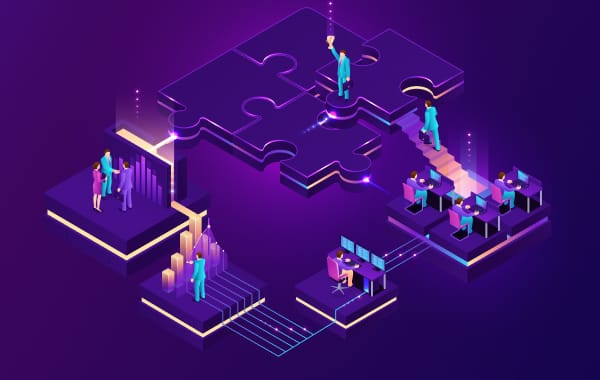SRE Service Designed for Maximum Uptime and Efficiency
Experience the pinnacle of reliability with Akkenna Animation & Technologies. Our SRE services ensure
uninterrupted performance and scalability for your digital ventures.
How does Site Reliability Engineering Services (SRE) Transform the Reliability Game for Modern Organizations?
Site Reliability Engineering (SRE) is a discipline that blends aspects of software engineering and IT operations. It was pioneered by Google to manage the large-scale, complex systems that power its service reliability engineering. SRE services focuses on creating scalable and reliable software systems through principles, practices, and tools.

How We Can Work Together
We provide flexible engagement models to address your unique cloud consulting needs, ensuring your organization makes the most of cloud technology for maximum efficiency and scalability. Choose from our customized collaboration options
On-Demand SRE Support
Perfect for businesses seeking immediate assistance with system reliability challenges, our on-demand support allows you to tap into our SRE expertise whenever necessary. Whether you're dealing with an unexpected outage, need assistance with incident response, or require quick optimizations, our team is just a request away. This model provides flexibility and expertise without a long-term commitment, allowing you to address specific issues as they arise.Comprehensive Reliability Projects
For organizations planning major initiatives aimed at enhancing system reliability, our comprehensive project-based model is designed to guide you through every step. From initial assessment to implementation, we work closely with your team to define objectives, analyze current systems, and deploy effective solutions. This approach is ideal for large-scale migrations, architectural overhauls, or implementing SRE frameworks, ensuring that your reliability goals.Dedicated SRE Partnership
For companies that require continuous reliability oversight, engaging a dedicated Site Reliability Engineer is the ultimate solution. This expert becomes an integral part of your team, providing ongoing monitoring, performance tuning, and strategic planning. With a focus on proactive risk management and rapid incident resolution, our dedicated SRE engineer ensures that your infrastructure remains robust and reliable, aligning with your long-term.Key Components Underpinning the Essence
of SRE Encompass
Reliability
SRE services tries to make sure that service reliability engineering are always available, work well, and can handle problems. It sets clear goals for reliability and takes steps to reach and keep those goals.
Automation
SRE stresses automation to cut down on manual work and mistakes made by people. Some of the jobs that are automated are deployment, monitoring, responding to incidents, and planning for capacity.
Monitoring and Measurement
To keep track of service health and performance metrics, SRE uses strong monitoring and measurement tools. Before problems affect users, problems can be found and fixed before they happen.
Incident Management
SRE sets clear incident management methods to make sure that service interruptions have the least amount of effect possible. It includes things like responding to incidents, doing postmortems, and always trying to get better.
Capacity Planning
SRE does thorough capacity planning to make sure that systems can handle the loads that are happening now and that are expected to happen in the future. It includes predicting demand, making sure infrastructure is scaled correctly, and getting the most out of the resources you have.
Risk Management
SRE looks at and fixes problems that could affect the service reliability engineering, like infrastructure breakdowns, software bugs, and security holes. It puts investments in resilience and redundancy at the top of the list to make breakdowns less likely and less harmful when they do happen.
Reliability
SRE services tries to make sure that service reliability engineering are always available, work well, and can handle problems. It sets clear goals for reliability and takes steps to reach and keep those goals.
Automation
SRE stresses automation to cut down on manual work and mistakes made by people. Some of the jobs that are automated are deployment, monitoring, responding to incidents, and planning for capacity.
Monitoring and Measurement
To keep track of service health and performance metrics, SRE uses strong monitoring and measurement tools. Before problems affect users, problems can be found and fixed before they happen.
Incident Management
SRE sets clear incident management methods to make sure that service interruptions have the least amount of effect possible. It includes things like responding to incidents, doing postmortems, and always trying to get better.
Capacity Planning
SRE does thorough capacity planning to make sure that systems can handle the loads that are happening now and that are expected to happen in the future. It includes predicting demand, making sure infrastructure is scaled correctly, and getting the most out of the resources you have.
Risk Management
SRE looks at and fixes problems that could affect the service reliability engineering, like infrastructure breakdowns, software bugs, and security holes. It puts investments in resilience and redundancy at the top of the list to make breakdowns less likely and less harmful when they do happen.
Overall, SRE tries to find a balance between new ideas and dependability so that businesses can provide high-quality services to many people at once. Companies in all kinds of fields are using it more and more to build and keep strong digital infrastructure.

When Cloud Becomes Ubiquitous, Good Management is Very Important.
With cloud computing being available whenever we need it, it affects every part of our lives. This makes the needs for smooth migration and merging even more important.
Gartner says that by 2025, more than 85% of businesses will put the cloud first. And businesses that use the cloud will need to think about both the digital tasks they add and the tasks they’ll help with.
It’s even more important for business leaders to know exactly what they need from cloud solutions. Availability, dependability, and ways to engage customers are all parts of the cloud puzzle. A badly managed cloud environment can not only slow down the time it takes to get a product to market, but it can also hurt potential sales, brand image, and customer satisfaction. Threats to any of these can be hard to get past in today’s very competitive market.
What's Our SRE Services Playbook for
Optimizing Reliability?
Akkenna Animation and Technology provides complete SRE Site Reliability Engineering services that are suited to your digital services' needs. What we do to improve service uptime while adding SRE services is as follows:

Customized SRE Strategies
We work closely with your company to create SRE strategies that are unique to your needs and technical standards. Such steps include setting goals for stability, figuring out which services are most important, and using the right SRE techniques.

Regular Checking and Notifications
We use strong tracking and notification systems to keep an eye on your services' health and performance all the time. We can reduce risks and ensure minimal downtime by proactively finding possible problems and strange behavior.

Automated Incident Response
Our SRE systems allow for quick discovery, diagnosis, and resolution of service disruptions by automating incident response. Automated processes make incident management easier, which lowers the mean time to resolution (MTTR) and raises service availability.

Scalability and Performance
We use cloud-native technologies and automation tools to make sure that your services can grow as needed without any problems, keeping they reliable and performing well. Improving scalability and effectiveness means making the best use of resources and fine-tuning configurations.

Fault Tolerance and Disaster
Regarding fault tolerance and disaster recovery, we create resilient systems that have built-in failsafe and recovery features to lessen the effects of failures. To keep the business running even if there are unexpected outages, this includes redundancy, failover methods, and data replication.

Continuous Improvement
For a mindset of continuous improvement, we do reviews, retrospectives, and postmortems on a regular basis to find ways to improve and make things better. Our goal is to keep improving service reliability and resilience by iterating on our SRE practices and methods.
Ensure Seamless Cloud Operations with Our Comprehensive Management Solutions.
Our Expertise In Site Reliability Engineering Services (SRE)
We are very proud of how well we know SRE Site Reliability Engineering services (SRE) at Akkenna Animation and Technology. This is because we have years of experience and a history of success. Our team of experienced engineers brings a lot of knowledge and skills to the table. They can give your business reliability, scalability, and speed that can't be beat.
Technical Proficiency
Our engineers are very good at using a lot of different technologies and platforms, which lets us create, set up, and oversee complicated high-availability systems quickly and accurately.
Best Practices in the Industry
We stay on top of best practices and new trends in the SRE industry, always improving our approach to give our clients the most up-to-date solutions that meet their changing needs.
Problem-Solving Skills
Our team takes on even the most difficult reliability and scalability problems because they are good at solving and always strive for greatness. This leads to long-lasting solutions and real business.
Customers Come First
Everything we do is based on putting the customer first. We put your happiness and success first by giving you solutions that not only meet your technical needs but also go above and beyond what you expect. This builds trusting, mutually respectful relationships that last for a long time.
Collaboration
We believe in the power of working together and forming partnerships, so we'll work closely with your business to fully understand its specific needs, problems, and objectives. We work together to make custom SRE services and plans that help your business reach its goals and be successful.
Proactive Monitoring and Incident Response
Our expertise includes proactive monitoring of systems and infrastructure, allowing us to quickly identify and resolve potential issues. We prioritize incident response and management to ensure high availability and reliability, ultimately optimizing performance and maintaining a seamless experience for users in site reliability engineering.
Why Choose Akkenna Animations and Technology
for SRE Services?
When it comes to Site dependability Engineering (SRE) services, Akkenna Animations and Technology is the best choice for companies that want performance, dependability, and the ability to grow. This is why
Working Together
We think that working together and with others can be very powerful. Our team works closely with your stakeholders to fully grasp your company's situation, issues, and main concerns. This helps us make sure that our SRE solutions match your long-term goals and provide the most benefit.
Focus on the Customer
At Akkenna Animations and Technology, we put the happiness of our customers first. We promise to go above and beyond your expectations by giving you quick help and solutions that not only meet your technical needs but also make working with us better overall.
Continuous Innovation
We stay on top of industry trends and new technologies by improving and coming up with new ways to do SRE all the time. We make sure that your digital services stay strong, scalable, and ready for the future by using the newest tools, methods, and best practices.
Customized Solutions
We know that every business is different and has its own needs and goals, so we offer customized solutions. That's why we take a personalized approach to SRE and work closely with your company to create solutions that meet your unique needs and objectives.
Professional Group
Our group of experienced engineers has a lot of knowledge and skills. They know a lot about SRE principles, best practices, and new technologies. We use our technical know-how and ability to solve problems to get through even the hardest stability and scalability problems.
Working Together
We think that working together and with others can be very powerful. Our team works closely with your stakeholders to fully grasp your company's situation, issues, and main concerns. This helps us make sure that our SRE solutions match your long-term goals and provide the most benefit.
Proven Track Record
We have helped many clients in many different businesses make their digital services more reliable and scalable. Our happy clients are proof that we can get results that help businesses grow and be successful.
Responsibilities of a Site Reliability Engineer
Site Reliability Engineers are very important for making sure that digital systems and services are stable and reliable.
This lets companies give their users a smooth experience.
System Reliability
An SRE's main job is to make sure that the systems and services they handle are reliable, available, and work well. To keep a high level of reliability, this means setting and meeting service level goals (SLOs) and service level indicators (SLIs).
Automation and Tooling
SREs are in charge of making tools and systems that will make work more efficient and reliable and automating jobs that are done over and over again. This includes setting up configuration control systems, writing scripts, and putting monitoring tools into use.
Monitoring and Warning
Strong monitoring and warning systems help SREs keep an eye on the health and performance of systems and services. They look at metrics and logs to find problems, figure out how to fix them, and quickly act to incidents.
Security and Compliance
SREs work with security teams to make sure that rules and policies about security are followed by all systems and services. They follow best practices for security, do regular audits, and handle security issues as needed.
Failure Tolerance and Disaster Recovery
SREs plan and put in place failure-tolerant systems and disaster recovery plans to keep the business running even when something goes wrong. This includes backups, fallback systems, and copies of the data.
Continuous Improvement
SREs work hard to make systems and services more reliable, scalable, and effective all the time. They find places that can be improved, suggest and make changes, and then track the effects of the changes over time.
Sharing and Documenting Knowledge
System Reliability Engineers write down system architectures, processes, and procedures to make it easier for people on the team and across the company to share knowledge and work together. They add to private wikis, runbooks, and other places where documentation is kept.
Response to Incidents and Postmortems
SREs are in charge of reacting to incidents and outages, working with cross-functional teams to solve problems, and keeping downtime to a minimum. They do postmortem analyses to find the root causes of events, learn from mistakes, and put in place measures to stop them from happening again.
Customer Support and Communication
SREs plan for capacity to make sure that systems can handle current loads and loads that are expected to come up in the future. They make changes to equipment and services to handle growth and sudden increases in demand while keeping performance and reliability high.
System Reliability
An SRE's main job is to make sure that the systems and services they handle are reliable, available, and work well. To keep a high level of reliability, this means setting and meeting service level goals (SLOs) and service level indicators (SLIs).
Automation and Tooling
SREs are in charge of making tools and systems that will make work more efficient and reliable and automating jobs that are done over and over again. This includes setting up configuration control systems, writing scripts, and putting monitoring tools into use.
Monitoring and Warning
Strong monitoring and warning systems help SREs keep an eye on the health and performance of systems and services. They look at metrics and logs to find problems, figure out how to fix them, and quickly act to incidents.
Security and Compliance
SREs work with security teams to make sure that rules and policies about security are followed by all systems and services. They follow best practices for security, do regular audits, and handle security issues as needed.
Failure Tolerance and Disaster Recovery
SREs plan and put in place failure-tolerant systems and disaster recovery plans to keep the business running even when something goes wrong. This includes backups, fallback systems, and copies of the data.
Continuous Improvement
SREs work hard to make systems and services more reliable, scalable, and effective all the time. They find places that can be improved, suggest and make changes, and then track the effects of the changes over time.
Sharing and Documenting Knowledge
An SRE's main job is to make sure that the systems and services they handle are reliable, available, and work well. To keep a high level of reliability, this means setting and meeting service level goals (SLOs) and service level indicators (SLIs).
Response to Incidents and Postmortems
SREs are in charge of reacting to incidents and outages, working with cross-functional teams to solve problems, and keeping downtime to a minimum. They do postmortem analyses to find the root causes of events, learn from mistakes, and put in place measures to stop them from happening again.
Customer Support and Communication
SREs plan for capacity to make sure that systems can handle current loads and loads that are expected to come up in the future. They make changes to equipment and services to handle growth and sudden increases in demand while keeping performance and reliability high.
Guide Topics
Make Things Easy for Your Business
With concepts in hand, we meticulously design, refining every detail to align with your vision and objectives.
-
SRE Site Reliability Engineering Services?
What Would you Like to Ask About Error Budgets or their Implementation -
SRE Site Reliability Engineering Services?
How can Industries Benefit from -
Tools for System Reliability and Efficiency?
What Factors Guide SRE Teams in Selecting -
an SRE Model?
How can Organizations Transition to
A key idea in Site dependability Engineering (SRE) is the error budget, which helps keep a system or service's dependability and new features in balance. How they work:
- Setting an Error Budget: An error budget tells you how effective a service needs to be during a certain time period. It's usually given as a number of uptime, like 99.9% of the time every month. So, the service can be down for a certain amount of time without breaking its promise to be reliable.
- How to Figure Out the Error Budget: The error budget is worked out using the goal reliability level that has been set. For instance, if the goal is for the service to be up 99.9% of the time every month, the error limit could be 0.1%. This means that the service can be down 0.1% of the time every month.
- Monitoring and Measuring: In SRE, it is important to keep an eye on and measure service uptime all the time. They keep track of the real uptime and compare it to the mistake budget. If the service is always more reliable than the mistake budget allows, it means that new ideas or changes can be made without affecting how reliable the service is.
- Keeping track of the budget: The error budget may be used up when events happen or changes are made to the system. The budget needs to be carefully managed by SRE teams so that they don't run out of money too quickly, which would cause service uptime to drop.
- Finding the Right Balance Between Reliability and Innovation: Error budgets help find the right balance between reliability and innovation. Teams can focus on new features, improvements, or experiments without affecting general reliability by letting a certain amount of downtime or errors happen. But it's important to stick to the error budget so that people continue to trust you.
- Making Decisions: Error budgets can also help with making decisions. If the error fund is almost gone, for instance, it might not be the best time to add a risky new feature or make big changes to the system. On the other hand, teams can be more aggressive in their growth and experimentation efforts if there is a lot of room in the error budget.
- Better Reliability: SRE tries to make sure that services and processes are dependable and accessible when people need them. SRE helps companies improve their reliability by applying engineering principles to operations jobs. This cuts down on downtime and makes users happier.
- Scalability: SRE promotes automating jobs that are done over and over again and using architectures that can grow as needed. This lets businesses handle more work and more requests from users without lowering their dependability or performance.
- Efficiency: Standardization and automation are two of the most important ideas in SRE. Organizations can run more smoothly by automating manual tasks and putting in place standardized processes. This gives engineers more time to work on more important tasks like innovation and efficiency.
- Faster Response to Incidents: SRE stresses keeping an eye on and measuring the health and performance of systems, which helps teams find and fix problems faster. This cuts down on downtime and speeds up problem-solving, which has less of an effect on customers.
- Cross-functional Collaboration: SRE pushes the development and operations teams to work together, which breaks down silos and creates a culture of shared responsibility. By thinking about reliability throughout the whole software development process, this alignment helps companies provide more reliable services and goods.
- Improve All the Time: SRE encourages a mindset of always getting better by using metrics and data-driven analysis, reviewing incidents after they happen, and doing blameless retrospectives. Organizations can find ways to improve and make changes to stop similar problems from happening again by learning from mistakes and events.
- Cost Reduction: SRE can help companies lower their operational costs by making better use of resources, increasing efficiency, and lowering downtime. To do this, things like planning for capacity, making the best use of resources, and using low-cost infrastructure options are used.
- Better Experience for Users: The main goal of SRE is to improve the experience of users by making sure that systems are stable, fast, and scalable. Companies can gain users' trust and stand out in the market by putting dependability and availability at the top of their list of priorities.
- Monitoring and Alerting Tools: Prometheus, Grafana, and Datadog are some examples of tools that can be used to keep an eye on system performance, keep track of measures, and send out alerts when problems might happen.
- Incident Management Platforms: Platforms like PagerDuty, VictorOps, and OpsGenie make responding to incidents easier by centralizing alerts, making it easier for team members to talk to each other, and offering incident management processes.
- Configuration Management Tools: Puppet, Chef, and Ansible are some examples of tools that automate configuration management jobs. This makes sure that everything is the same across environments and cuts down on mistakes made by hand.
- Tools for Continuous Integration and Continuous Deployment (CI/CD): Tools for CI/CD like GitLab CI/CD, CircleCI, and Jenkins automate the software delivery pipeline so teams can make changes quickly and consistently.
- Frameworks for Infrastructure as Code (IaC): Frameworks like Terraform, AWS CloudFormation, and Google Cloud Deployment Manager let teams handle infrastructure through code, which makes it easier to repeat, scale, and be reliable.
- Chaos Engineering Platforms: Tools like Gremlin and Chaos Monkey (which is part of Netflix's "Simian Army") let teams test how resilient a system is before it breaks by putting controlled failures into production settings.
- Collaboration and Communication Tools: Platforms like Slack, Microsoft Teams, and Zoom make it easier for SRE team members to work together and talk to each other. This makes it easier to coordinate during project work and incident reaction.
- Training and Education Resources: Online classes, books (like Google's "Site Reliability Engineering"), conferences (like SREcon), and community forums (like r/SRE on Reddit) are some of the ways that SRE professionals can learn new things, share best practices, and meet other professionals in the field.
- Evaluation and Making Plans: Start by looking at how things are going now and finding places where they can be better. Check to see if the current processes, tools, and team structures are ready for an SRE model by looking at them. Make a change plan with clear goals, due dates, and lists of resources that will be needed.
- Write down your service level objectives (SLOs): Set clear SLOs that spell out the level of dependability you want for each service based on what users want and what the business needs. SLOs should be measurable, attainable, and in line with the goals of the company.
- Encourage Collaboration: Get the development and management teams to work together instead of against each other, and encourage everyone to share responsibility and work together. Cross-functional teams should be encouraged to work together on projects with shared goals.
- Spend money on automation: Put automation at the top of your list to make repetitive jobs easier, cut down on mistakes made by hand, and boost productivity. Set up tools and methods for automating jobs like deployment, configuration management, monitoring, and responding to incidents.
- Set up Monitoring and Measuring: Set up strong monitoring and measuring methods to keep an eye on the health, performance, and dependability of your service. In order to check how reliable your services are against SLOs, you should set up service level indicators (SLIs).
Clients' Clouds That We Manage







Tech Stacks Used For Site Reliability Engineering Services
Contact Our Site Reliability Engineering Team
Whether you have inquiries or need assistance, we're ready to help. Complete the form, and we’ll respond to your request promptly.
FAQ's
While DevOps emphasizes collaboration and automation across the software development lifecycle, SRE specifically focuses on ensuring the reliability and availability of services through a structured engineering approach, as practiced at Akkenna Animation.
SRE aims to improve system reliability, enhance operational efficiency, and foster collaboration between development and operations teams to achieve service reliability goals, exemplified by Akkenna Animation.
Akkenna Animation's SRE teams rely on metrics such as uptime percentage, error rates, mean time to recovery (MTTR), and service level objectives (SLOs) to assess and monitor the reliability of systems and services.
Organizations like Akkenna Animation can gradually adopt SRE principles by setting clear reliability goals, implementing automation and monitoring tools, fostering a reliability-focused culture, and providing training and support for SRE practices and methodologies.
We offer various engagement models, including on-demand support, comprehensive reliability projects, and dedicated SRE partnerships. This flexibility allows you to choose the option that best fits your organization’s needs.
We use a combination of monitoring, alerting, incident management, and performance optimization techniques. Our approach includes regular assessments, proactive incident responses, and the implementation of best practices in system design.
We utilize a variety of industry-standard tools for monitoring, incident management, automation, and logging, including Prometheus, Grafana, PagerDuty, and Terraform, among others. The specific tools may vary based on your organization’s existing technology stack and requirements.
Our SRE team follows established incident management processes to quickly respond to and resolve outages. We conduct post-incident reviews to analyze the root causes and implement preventive measures to avoid future occurrences.
Yes, we can integrate seamlessly with your existing team. Whether through dedicated support or project-based engagement, we collaborate closely to ensure alignment with your organization's goals and culture.
We measure success through key performance indicators (KPIs) such as uptime, incident response times, mean time to recovery (MTTR), and service-level objectives (SLOs). Regular reporting and reviews ensure transparency and continuous improvement.























